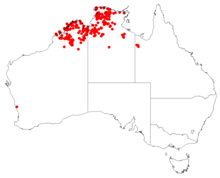| Cochlospermum fraseri | |
|---|---|

| |
| Conservation status | |
 Least Concern (TPWCA) | |
| Scientific classification | |
| Kingdom: | Plantae |
| Clade: | Tracheophytes |
| Clade: | Angiosperms |
| Clade: | Eudicots |
| Clade: | Rosids |
| Order: | Malvales |
| Family: | Bixaceae |
| Genus: | Cochlospermum |
| Species: | C. fraseri |
| Binomial name | |
| Cochlospermum fraseri Planch. | |

| |
| Occurrence data from AVH | |
| Synonyms | |
| |
Cochlospermum fraseri is a tree in the family Bixaceae with common names cotton tree, kapok bush, and kapok tree. It is native to northwestern Australia from the Kimberly region of Western Australia to the northern parts of the Northern Territory.
Description
Cochlospermum fraseri is a deciduous shrub or small tree which can grow to 7 m tall. It flowers from March to October, the inflorescence being a terminal panicle. The flowers are asymmetric, having five sepals in two whorls, with the outer two sepals being shorter than the inner three, and it has numerous stamens. The flowers often appear when the plant has no leaves. It fruits from June to March, with the fruit being a woody capsule having 3 to 5 valves. The seeds are surrounded by fluffy, "cottony" threads, giving rise to the common name kapok tree.
Taxonomy
French botanist Jules Émile Planchon described this species in 1847 from Melville Island off the north coast of Australia. Two subspecies are recognised: subspecies fraseri, found mainly from Katherine to Melville Island, has smooth leaves and 2 mm-long bracts, and subspecies heteronemum, from Katherine west to the Ord River, has finely furred leaves and 40–58 mm-long bracts.
Distribution and habitat
It is found in the bioregions of Central Kimberley, Dampierland, Gulf Fall and Uplands, Northern Kimberley, Ord Victoria Plain, Pine Creek, Victoria Bonaparte in the Northern Territory., and the bioregions of Central Kimberley, Dampierland, Great Sandy Desert, Northern Kimberley, Ord Victoria Plain, Victoria Bonaparte in Western Australia.
Cochlospermum fraseri grows in open eucalypt woodland on a variety of soils, including sands, gravelly soils, and heavy clay soils.
Uses
The indigenous people of northern Australia would eat the flowers, either raw or cooked, and the roots of young plants. They also used to use the fluff from the seeds as body decoration.
This plant is a "calendar" plant of the Jawoyn people: flowering indicates when freshwater crocodiles are laying eggs, fruiting the time for collecting them.
Gallery
References
- "Cochlospermum fraseri". Australian Plant Name Index (APNI). Centre for Australian National Biodiversity Research, Australian Government. Retrieved 16 May 2024.
- ^ "Cochlospermum fraseri Planch". Plants of the World Online. Royal Botanic Gardens, Kew. 2024. Archived from the original on 4 December 2024. Retrieved 16 May 2024.
- "Cochlospermum fraseri". Atlas of Living Australia. National Collaborative Research Infrastructure Strategy (NCRIS), Australian Government. Retrieved 16 May 2024.
- ^ "Cochlospermum fraseri Planch". Western Australian Herbarium (1998–). Florabase—the Western Australian Flora. Department of Biodiversity, Conservation and Attractions, Government of Western Australia. 2021. Archived from the original on 16 May 2024. Retrieved 16 May 2024.
- ^ "Cochlospermum fraseri". FloraNT, Northern Territory Herbarium. Northern Territory Government, Darwin. 2013. Retrieved 16 May 2024.
- ^ Brock, John (2001). Native plants of northern Australia. Sydney: Reed New Holland. p. 124. ISBN 9781925546828. Archived from the original on 16 May 2024. Retrieved 16 May 2024.
{{cite book}}: CS1 maint: bot: original URL status unknown (link) - ^ Moore, Phillip (2005). A Guide to Plants of Inland Australia. Sydney: Reed New Holland. p. 504. ISBN 9781876334864. Archived from the original on 16 May 2024. Retrieved 16 May 2024.
- Planchon, Jules Émile (1847). "Sur la nouvelle famille des Cochlospermées". London Journal of Botany (in French). 6: 307 – via BHL.


